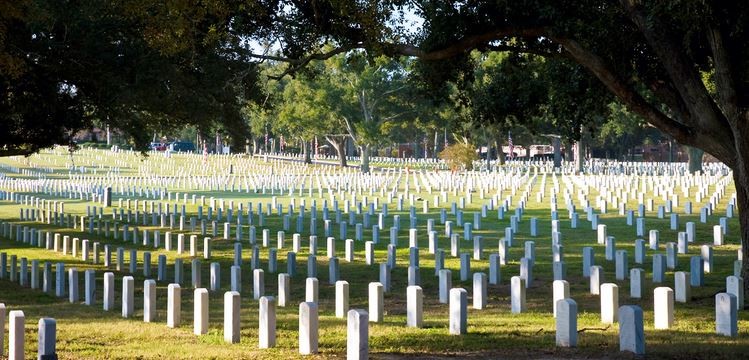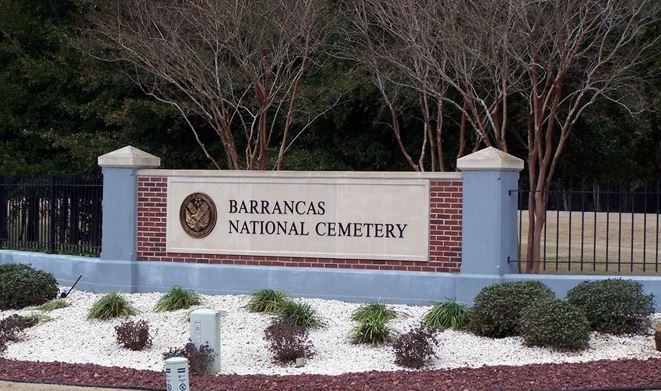Barrancas National Cemetery
Introduction
Text-to-speech Audio
Barrancas National Cemetery is located inside the Pensacola Naval Station.This historic cemetery dates back to the creation of Fort Barrancas in 1838. After acquiring Florida as part of the 1819 Adams-Onís Treaty, the United States began to create forts along the coastline. Fort Barrancas was one of these facilities, built upon the ruins of a colonial SPanish fort and guarding the entrance of Pensacola Bay from 1838 to 1947. Today, the fort has been reconstructed and offers public tours. The cemetery encompasses 94.9 acres and has approximately 43,000 burial sites that include four Medal of Honor recipients.In 1998, it was added to the National Register of Historic Places.
Images
Barrancas National Cemetery.

Entrance of Barrancas National Cemetery.

1893 Site Plan of Barrancas National Cemetery.

Backstory and Context
Text-to-speech Audio
Barrancas National Cemetery was established in 1814 on the site of the
old U.S. Navy Yard. In addition, a small cemetery was operated by the former Marine Hospital that was located near the fort. The cemetery
was expanded in 1838 and was then established as a naval cemetery. In
1868, the site was officially designated as Barrancas National
Cemetery and many of those that died at the Battles of Pensacola, Bayou
Chico, Gunboat Point, Santa
Rosa Island, East Pass, Apalachicola, San Juan Island, and Saint
Andrew’s Bay were buried here.
A lot of history still remains in tact on the property. The double-iron gate at the main entrance dates back to the year of 1868, and the pedestrian gate that sits nearby dates back to the year of 1936. Also, some of the original brick wall enclosing the cemetery remains intact along the site’s western border.
Most of the cemetery sites are laid out in uniform rows. As of 1869, there were already 1,130 burials that had been made in the cemetery. Also, victims of a 1930 outbreak of malaria and yellow fever, that also included children,are buried here. On the main website, it explains that in sections 1 thru 12, the remains of Civil War casualties are placed there. The cemetery is open from sunrise to sunset except on federal holidays (Memorial Day excluded).
Some of the notable people buried in Barrancas include:
A lot of history still remains in tact on the property. The double-iron gate at the main entrance dates back to the year of 1868, and the pedestrian gate that sits nearby dates back to the year of 1936. Also, some of the original brick wall enclosing the cemetery remains intact along the site’s western border.
Most of the cemetery sites are laid out in uniform rows. As of 1869, there were already 1,130 burials that had been made in the cemetery. Also, victims of a 1930 outbreak of malaria and yellow fever, that also included children,are buried here. On the main website, it explains that in sections 1 thru 12, the remains of Civil War casualties are placed there. The cemetery is open from sunrise to sunset except on federal holidays (Memorial Day excluded).
Some of the notable people buried in Barrancas include:
- Colonel George E. "Bud" Day, Former POW and Medal of Honor recipient for action in the Vietnam War.
- Commander Clyde Everett Lassen, Medal of Honor recipient for action in the Vietnam War.
- Major Stephen W. Pless, Medal of Honor recipient for action in the Vietnam War.
- Staff Sergeant Clifford Chester Sims, Medal of Honor recipient for action in the Vietnam War.
- Colonel Arthur D. Simons, Special Forces commander and leader of the Son Tay raid
- General Joe W. Kelly, former commander of Military Air Transport Service from 1960 to 1964.
- Admiral Maurice F. Weisner, former commander of US Pacific Command from 1976 to 1979.
- "Ga-Ah", one of the many wives of the Apache Indian Geronimo, who died of Bright's disease while being held captive.
- 17 casualties of the 2nd Seminole War.
- 10 British aviators (6 Royal Navy, 4 Royal Air Force) killed during training at the Naval Air Station during World War II.
Sources
http://www.cem.va.gov/CEM/cems/nchp/barrancas.asp
http://www.nps.gov/nr/travel/national_cemeteries/florida/barrancas_national_cemetery.html
Photo Credits: http://www.lsginc.com/pages/ourwork/detail.aspx?catid=2&id=67
http://www.nps.gov/nr/travel/national_cemeteries/florida/barrancas_national_cemetery.html
http://www.waymarking.com/gallery/image.aspx?f=1&guid=d14ca053-eca2-491e-baed-13d29e47aef5&gid=3
